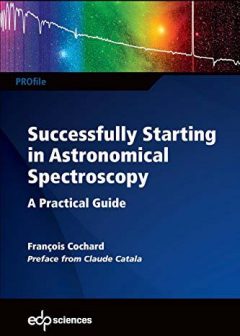Successfully starting in astronomical spectroscopy – a practical guide
| By François Cochard | Reviewed by David Boyd |
| EDP Sciences 2018 | 268 pages |
| Price £79 | ISBN:978- 27598-2026-9 |

Spectroscopy presents a steep learning curve to the newcomer, both in mastering the equipment and its use and in learning how to process the data it produces. This book aims to assist the new user up that learning curve. Does it succeed? Read on.
The book’s subtitle “A Practical Guide” accurately describes the author’s approach to introducing spectroscopy to the newcomer. As someone who has been climbing the spectroscopic learning curve myself over the past few years, I found the book addresses many of the issues I faced and gives the sort of practical advice I would have found very useful. It does this in a methodical way by progressively addressing the capabilities, both in equipment and skills, which the new user needs to acquire.
The early chapters introduce spectra and spectroscopy, provide a basic introduction to the physics of light and starlight, and discuss choosing the type of spectroscope most appropriate for different observing programmes including the trade-off between resolution and wavelength coverage. The emphasis here is on a realistic understanding of what is achievable. It is worth noting that the book only describes the use of spectroscopes employing a slit to isolate light from the target. The optical design of different types of slit spectroscope is illustrated with the Alpy and Lhires instruments produced by the author’s company Shelyak Instruments.
Chapters eight and nine are perhaps the most valuable for newcomers to spectroscopy as they describe how to set up a spectroscope for the first time on the bench during the day before ever connecting it to a telescope. This stage, which includes focusing and aligning the two cameras attached to the spectroscope, is crucial if the user is to achieve optimum performance. Attempting these adjustments outside at night for the first time will almost certainly lead to frustration and failure. The information provided here has been distilled from many years of helping new users and seeing the problems they encounter.
The book then moves on to describe how to make and reduce spectroscopic observations starting with the Sun since this does not require the user to attach the spectroscope to a telescope. The author illustrates the data reduction process using Christian Buil’s ISIS software, arguably the most advanced software freely available to the amateur community but software which has a steep learning curve for the new user. In the view of this reviewer it is a challenge worth overcoming as ISIS contains so much useful functionality that it repays the effort of learning it many times over.
After providing good practical advice on mastering control of a GOTO mount for the first time and learning the process of autoguiding, the author describes attaching the spectroscope to the telescope, balancing the equipment on the mount, and managing the plethora of cables involved. These are all tasks best performed in daylight. Finally the telescope must be focused at night so that a sharp stellar image is seen within the slit in the guiding image and the autoguider activated to keep the star centred in the slit for the duration of the exposure which may last many minutes.
The book finishes with a short reprise of the information in the preceding chapters by describing a typical observing session and provides pointers to ways in which the user can continue to improve their observational technique. The author underlines the importance of archiving spectra in one of the managed spectroscopic databases now available to ensure the data will be available to others.
Reading this book is like having an expert at your elbow who talks you thought the complex process of choosing a spectroscope, setting it up and using it to record high quality stellar spectra. At all stages the author provides sound advice based on years of experience helping new users. For a beginner starting out in spectroscopy, I strongly recommend this book as there are few sources which cover the whole process in such well-grounded detail.
Dr David Boyd has been exploring the potential of amateur spectroscopy for several years and has so far contributed over 300 spectra to the BAA Spectroscopy Database
| The British Astronomical Association supports amateur astronomers around the UK and the rest of the world. Find out more about the BAA or join us. |
